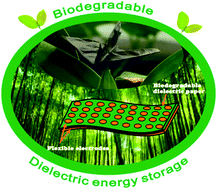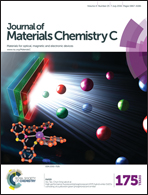Flexible dielectric papers based on biodegradable cellulose nanofibers and carbon nanotubes for dielectric energy storage†
Abstract
Flexible polymer-based dielectric materials that are used to store dielectric energy have widely been used in modern electronics and electric power systems, due to their relatively high energy density, light weight, low cost, etc. However, owing to the growing global environmental issues and a rapid consumption of nonrenewable polymer resources, there exists a strong desire to fabricate flexible dielectric materials using biodegradable materials. Here, we report on flexible dielectric papers based on biodegradable cellulose nanofibers (CNFs) and carbon nanotubes (CNTs) for dielectric energy storage. Highly ordered, homogeneous CNF/CNT papers have been fabricated using a facile vacuum-assisted self-assembly technique. The obtained paper possesses a high dielectric constant of 3198 at 1.0 kHz, thus leading to enhanced dielectric energy storage capability (0.81 ± 0.1 J cm−3), which is attributed to the presence of a low loading of CNTs (4.5 wt%). Moreover, the CNF/CNT papers are mechanically flexible and show improved mechanical strength. These findings enable feasible fabrication of high-performance flexible dielectric materials using ecofriendly materials.


 Please wait while we load your content...
Please wait while we load your content...